Enhanced TDS
Knowde-enriched technical product data sheet
Identification & Functionality
- Additives Included
- Chemical Family
- Polymer Name
- Plastics & Elastomers Functions
- Technologies
- Product Families
Features & Benefits
Applications & Uses
- Markets
- Applications
- Plastics & Elastomers End Uses
- Plastics & Elastomers Processing Methods
- Soft Touch in Spatulas and Kitchenware Application Data
Details
Arnitel® has low viscosity grades which give excellent flow behavior for 2K-molding .Benefits
Arnitel® TPC allows for reliable solutions because of its excellent adhesion with PBT in 2K injection molding, its superb scratch resistance (which make kitchen tools look better even after years of intensive usage), its chemical resistance (dish washer proof) and its approvals for direct food contact- Wine Taps Application Data
Details
The Wine Tap is used in bag and boxed wine packaging for distributing wine.Benefits
- Arnitel® has FDA approval for high alcohol contents and single use
- Arnitel® offers good elasticity and low hysteresis, resulting in good spring characteristics
- Arnitel® has good colorability with a stable white base color
- Support Springs Application Data
Details
Low creep flexing solution for slats and mattresses, creating ultimate sleep comfort by changing durometer per section of your bed.
Benefits
- Arnitel® has high creep resistance
- Arnitel® offers a wide range of flexible products, creating the ultimate solution
- Arnitel® offers easy processing, creating design flexibility
- DC Cables Application Data
Details
DC Cables are generally used for standard electronics charging systems, like adapters. The latest designs can also be used for USB-C charging, leading to much thinner cables than AC with similar charging and safety characteristics.
Benefits
- Arnitel® has a proven track record in wire and cable, also in ultra thin cables in all application areas
- Arnitel® offers a long history in commercial production and use in major electronics OEM
- Arnitel® solutions are known to most cable extrusion companies
- Arnitel® is easy to color with consistent haptics
- Outdoor Consumer Cables Application Data
Details
Thin low voltage consumer electornics cabling, used in the outdoor environment to accommodate the use of electronics in the field, i.e. camera's, sensors etc.
Benefits
- Arnitel® Wire & Cable grades exceed the UL758 for signal, AC and DC applications
- Arnitel® offers most colors possible without strong discoloration in UV
- Arnitel® has a long track record in outdoor applications
- Phone Case Application Data
Details
Product designers and manufacturers increasingly rely on thermoplastic elastomer (TPE) material solutions to produce and deliver highly durable and high-quality soft touch parts. Compared to the thermoplastic polyurethane (TPU) materials traditionally used for soft-touch manufacturing, TPEs offer better resistance to warpage and fatigue, as well as better protection against UV, chemical, and oil exposure.Benefits
- Broad tactile properties with superior touch and feel
- Broadest operating temperature range from -45°C to 150°C
- High tear and abrasion resistance
- High fatigue endurance after 255 compression cycles
- Grips Application Data
Details
Grips are applicable to consumer appliances such as kitchenware, household utensils, hand tools, game controllers and much more. The material is usually overmolded on PC, PC/ABS or polyester.Benefits
- Arnitel® allows for excellent bonding in molding on miscellaneous in thin walls
- Arnitel® solution is dish washer proof and has good grease resistance
- Arnitel® solution offers good haptics
- Arnitel Spring in Monitor Arm Application Data
Details
Adjustable load bearing for monitor armBenefits
- Elasticity
- Low creep
- Adjustable load bearing
Properties
- Flame Rating
- Mechanical Properties
Value Units Test Method / Conditions Flexural Modulus 20 MPa ISO 178 Charpy Impact Strength (at +23°C) N kJ/m² ISO 179/1eU Charpy Impact Strength (at -30°C) N kJ/m² ISO 179/1eU Charpy Notched Impact Strength (at +23°C) N kJ/m² ISO 179/1eA Charpy Notched Impact Strength (at -30°C) N kJ/m² ISO 179/1eA Izod Notched Impact Strength (at +23°C) N kJ/m² ISO 180/1A Izod Notched Impact Strength (at -20°C) N kJ/m² ISO 180/1A Tensile Notched Impact Strength (at +23°C) N kJ/m² ISO 8256/1 - Thermal Properties
Value Units Test Method / Conditions Melting Temperature (10°C/min) 180 °C ISO 11357-1/-3 Glass Transition Temperature (at 10°C/min) -80 °C ISO 11357-1/-2 Glass Transition Temperature from DMTA (tan d) -74 °C ASTM D5026/D7028 Coefficient of Linear Thermal Expansion (parallel) 2.2 E-4/°C ISO 11359-1/-2 Coefficient of Linear Thermal Expansion (normal) 2.2 E-4/°C ISO 11359-1/-2 Burning Behaviour (at 1.5 mm Nominal Thickness) UL HB class IEC 60695-11-10 Relative Temperature Index (Electrical, 1.5 mm) 50 °C UL746B Relative Temperature Index (with impact, 1.5 mm) 50 °C UL746B Relative Temperature Index (without impact, 1.5 mm) 50 °C UL746B - Electrical Properties
Value Units Test Method / Conditions Volume Resistivity 5E12 Ohm*m IEC 62631-3-1 - Rheological Calculation Properties
Value Units Test Method / Conditions Density of Melt 905 kg/m³ - - Other Properties
Value Units Test Method / Conditions Water Absorption 0.8 % Sim. to ISO 62 Density 1080 kg/m³ ISO 1183 Apparent Density 645 kg/m³ ISO 60 - Mechanical Properties (TPE)
Value Units Test Method / Conditions Tensile Modulus 25 MPa ISO 527-1/-2 Stress at 5% strain 1.3 MPa ISO 527-1/-2 Stress at 10% strain 2.1 MPa ISO 527-1/-2 Stress at 50% strain 4.5 MPa ISO 527-1/-2 Stress at 100% strain 5.1 MPa ISO 527-1/-2 Stress at Break 15 MPa ISO 527-1/-2 Strain at Break >300 % ISO 527-1/-2 Nominal Strain at Break 900 % ISO 527-1/-2 Shore A Hardness (3s) 85 - ISO 868 Shore D Hardness (3s) 25 - ISO 868 - Rheological Properties
Value Units Test Method / Conditions Melt Volume-Flow Rate (at 230 / * °C, 2.16 / * kg) 48 cm³/10min ISO 1133 Molding Shrinkage (parallel) 1 % Sim. to ISO 294-4 Molding Shrinkage (normal) 1 % Sim. to ISO 294-4
Regulatory & Compliance
- Certifications & Compliance
- Quality Standards
Technical Details & Test Data
- Chemical Resistance
Chemical Type Chemical Name Resistance Other Acetic acid (10% by mass) at 23°C resistant Ketones Acetone at 23°C resistant Other Ammonium hydroxide (10% by mass) at 23°C limited resistant, tests necessary to verify Other ASTM 1 at 23°C resistant Other ASTM 3 at 23°C resistant Other Brake fluids (DOT 3/4) at 23°C not resistant Other Calcium chloride (10% by mass) at 23°C limited resistant, tests necessary to verify Other Chloroform at 23°C not resistant Ethers Diethyl ether at 23°C limited resistant, tests necessary to verify Alcohols Ethanol at 23°C limited resistant, tests necessary to verify Other Ethyl Acetate at 23°C limited resistant, tests necessary to verify Other Fuel; Diesel at 85°C resistant Other Hydrochloric acid (10% by mass) at 23°C resistant Other Hydrogen peroxide (30% by mass) at 23°C limited resistant, tests necessary to verify Other Nitric acid (10% by mass) at 23°C resistant Other Phosphoric acid (10% by mass) at 23°C resistant Other Sodium hydroxide (10% by mass) at 23°C resistant Other Sulfuric acid (30% by mass) at 23°C resistant Other Tetrachloroethylene at 23°C limited resistant, tests necessary to verify Hydrocarbons Toluene at 23°C resistant Other Transformer oil at 23°C not resistant Other Trichloroethylene at 23°C not resistant Other Water at 23°C resistant Other Zinc chloride (10% by mass) at 23°C resistant - Creep Modulus-Time 23°C
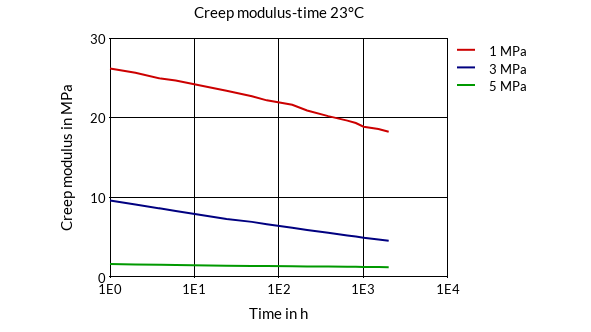
- Creep Modulus-Time 60°C
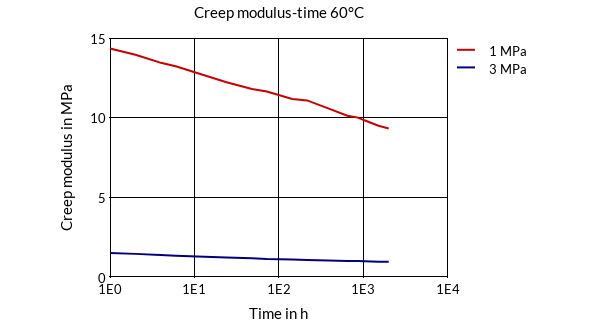
- Dynamic Shear Modulus (G)-Temperature
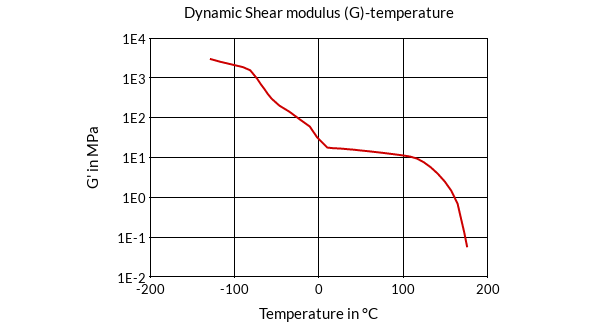
- Dynamic Tensile Modulus (E)-Temperature
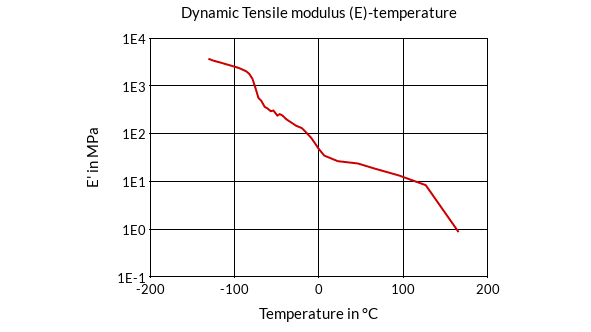
- Specific Volume-Temperature (pvT)
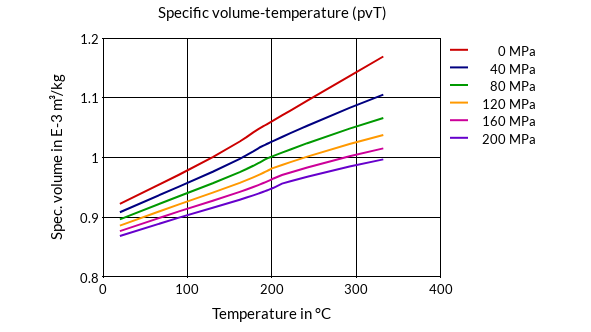
- Stress-Strain (TPE)
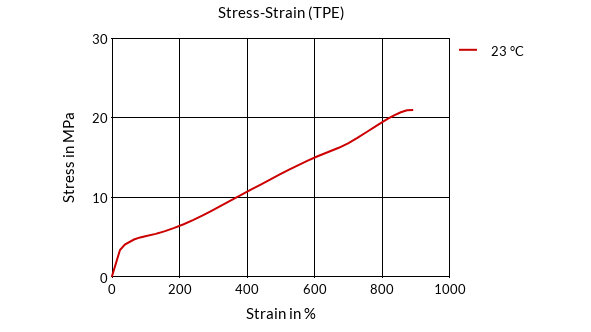
- Viscosity-Shear Rate
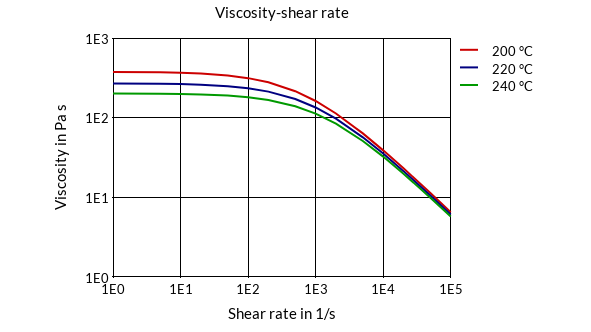
Packaging & Availability
- Packaging Type